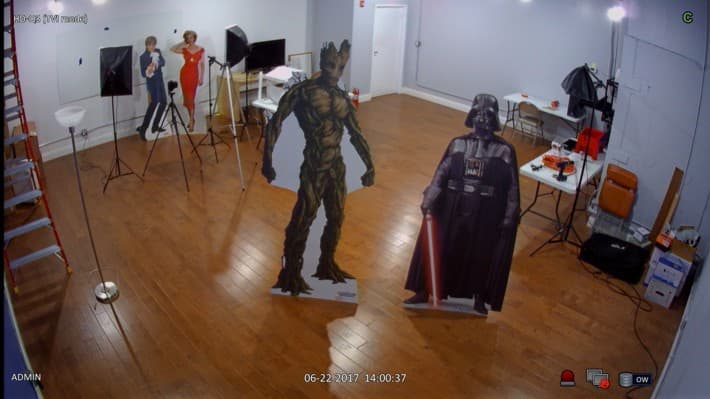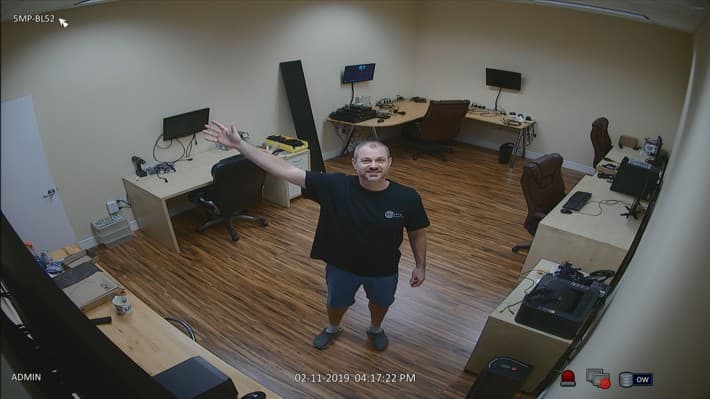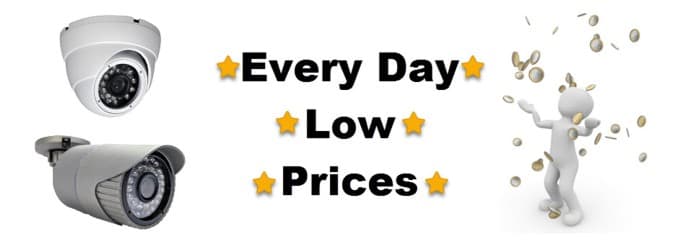2MP vs. 5MP HD Security Camera Resolution
The 2 Megapixel (1080p) image below was taken using our HD-Q3 HD security dome camera listed above. The 5 Megapixel image below was taken using our
5MP-BL52 HD lipstick camera. These images are here for users to compare the image quality of a 2 Megapixel camera to a 5 Megapixel camera. As you can see from the images below, the image quality of the two cameras is very similar. However, the pixel size of the images is the main differentiator. The pixel size of the 5 Megapixel camera is roughly two-and-a-half times the pixel size of the 2 Megapixel image.
For most users, the 2 Megapixel image will be more than sufficient for their surveillance application. The only time a 5 Megapixel camera would have an advantage is if the user attempts to zoom in on a previously recorded image. The larger pixel size of the 5 Megapixel camera will allow the user to zoom in further than the 2 Megapixel camera before distorting the image.
Please click on the images below to view their full resolution.
HD-Q3 2 Megapixel HD Dome Image

5MP-BL52 5 Megapixel HD Lipstick Image

Camera Model FAQ
Are these cameras new?
Yes, all of the cameras listed on this page are brand new and have never been opened. This page simply features our most capable entry-level cameras at an affordable price. These are not the usual off-the-shelf cameras that you will find at most big-box retailers that offer little to no tech support and subpar image quality, but rather these are cameras that we've tested in our office and have been impressed with the superior image quality that they offer.
Who is the manufacturer of these cameras?
We are the OEM manufacturer for all of the Analog cameras and equipment that we supply not only on this page but across our entire site. As for the IP cameras and equipment, the manufacturers are Zavio and Geovision, both of which we are master distributors for.
Why are these cameras less expensive?
The security cameras on this page are lesser expensive than some of our other models because of the components that they feature. For example, the cameras on this page all feature fixed, wide-angle lenses with a field of view that cannot be adjusted like on our more expensive
varifocal surveillance cameras can be. The cameras on this page have an infrared range of about 70 to 100 feet while some of our more expensive models have an infrared night vision range of 100 to 250 feet in low to no light environments. Another factor to consider is the image quality of the cameras. For the most part, the cameras on this page are all 1080p resolution. Some of our more expensive models feature resolutions ranging from 3 to 12 megapixel. The final element that should be taken into consideration is the weatherproof rating of the outdoor camera models. The outdoor security cameras featured on this page all have an IP66 weatherproof rating, which protects the vital components of the camera from harsh weather, dust, and humidity. Our more expensive cameras feature higher weatherproof ratings, such as IP67 or IP68, that allow the camera to be submerged for a short period of time and IK8 vandal proof ratings that protect the camera from acts of vandalism.
Are these good home security cameras?
Yes, the cameras on this page are ideal for home and small business surveillance system applications. They are best for home applications because the fixed lens is generally the perfect angle of view for monitoring the perimeter and interior of most small to medium-sized homes. On applications with larger yards or warehouses to monitor, varifocal cameras may be a better fit because installers can dial-in custom viewing angles that are more sufficient than a fixed angle of view. While larger businesses may be able to afford the cost of an installer to mount the cameras and dial-in the perfect viewing angle, many homeowners cannot and want a system that they can easily install themselves. Because the lenses of these cameras are fixed, users can simply install the cameras by mounting them with the included hardware, aiming the lens in the direction they wish to surveil, and running the video and power cable from the camera to the DVR. For these reasons, these cameras make great home CCTV security cameras.
What other equipment do I need?
All of the cameras on this page only come with the camera itself, a power supply, and mounting hardware. If you wish to record, then a DVR (Digital Video Recorder) will be required for the Analog camera models and an NVR (Network Video Recorder) will be needed for the IP camera models. The IP cameras on this page also include a free recording software that can be installed on a Windows PC, negating the need for an NVR. For the Analog models, we recommend our
iDVR-PRO series DVRs because of the easy to use GUI (Graphical User Interface) and support for both standard Analog (CVBS) and HD Analog cameras.
For the IP cameras, we recommend either the included Windows software or a
Zavio standalone NVR for the Zavio cameras and a Geovision standalone NVR for the Geovision cameras. Each of these recording options supports mobile apps for remote viewing from iPhone and Android mobile devices. Additional power supplies are not required because single 12 volt DC transformers are included with all of our cameras. However, some users with multiple cameras wish to use a multi-channel power box, or POE switch for POE compliant IP cameras, to consolidate the amount of clutter and cable used.
Cabling is the last item required for these cameras. We recommend
pre-made Siamese cables or spools of RG59 / RG6 coaxial cabling for Analog cameras and Cat-5E network cable for IP cameras.
What if I have an existing security system?
If you are looking to add one of the cameras on this page to an existing security system, then a few things need to be taken into consideration. Do you have an Analog or IP system? If you currently have an Analog system, then the supported formats of the DVR must be noted first. A lot of older Analog equipment only supports standard definition (CVBS) cameras and do not support the latest HD Analog cameras. Existing coaxial cable can be used with the newer HD Analog formats so new cabling does not have to be run. If you wish to add an HD Analog camera to your system, then you must first ensure that your DVR supports at least one of the latest HD video formats, including AHD, HD-TVI, and HDCVI.
On the other hand, if your system is IP based you will need to ensure that your system supports either the exact camera model or ONVIF, which is an open standard that allows IP devices to sync with one another. As long as both the recorder and camera support ONVIF, they will be compatible with one another.
What if I do not want to record?
If a user does not need to record video and only wants the cameras for viewing real-time live video, then we recommend using a quad processor, or video multiplexer, for Analog cameras.
Quad processors/multiplexers do not record and are only used to display the live video of an Analog camera. They are ideal for security monitoring stations and can even be used to alert a security guard when motion is detected by emitting a loud beep. They can even be used for live display systems in the showrooms of retailers and offices. If the user only has a single Analog camera, then they could use an HD Analog to HDMI converter to connect the camera directly to an HDMI monitor for viewing.
The IP equivalent to a quad processor/multiplexer is an
IP decoder box and is recommended for live streaming IP cameras. These boxes do just as the name states and decodes the video streams of IP cameras so that they may be displayed live on an HDMI monitor.
Are any of these wireless security cameras battery powered?
At this time, CCTV Camera Pros does not supply any cameras with a rechargeable battery, such as Nest or Ring, because of the frequency in which the battery must be charged or replaced. All of the cameras that we supply must be hardwired for power. While hardwiring power to the camera(s) may seem like a lot of additional work, especially when compared to battery pack cameras, it actually saves a lot of work for the end-user over time because they do not have to go up on a ladder every so often to change or recharge batteries. Furthermore, users will have peace of mind knowing that their cameras' recording schedule is always up and running and not almost out of charge.
Can these cameras record to the Cloud?
While none of the cameras on this page can record to a cloud service, we do carry
Geovision IP Cloud-based cameras here. Please note that with cloud cameras, there is a monthly fee for recording. The rest of the surveillance equipment that we carry does not require a monthly fee to record or view live video and playback remotely.
|













